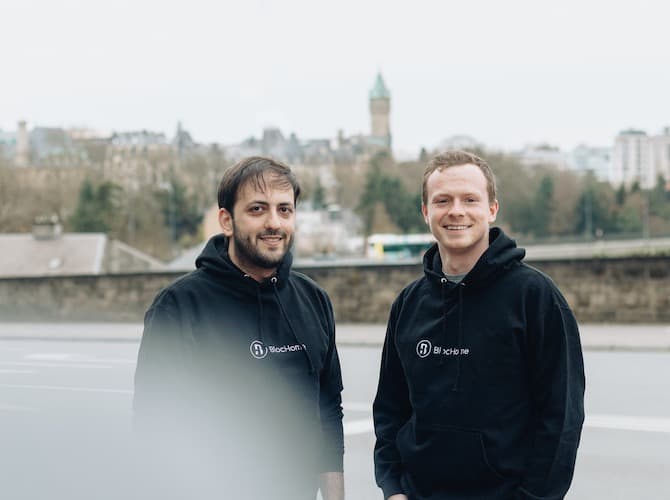Spiralling housing costs are outpricing huge swathes of the Luxembourg population. Cue tokenisation, the affordable and accessible way for investors to own bricks and mortar.
Raphael Scheuren and Maroun Altekly (pictured above) face the same problem as thousands of their peers. Despite being successful young professionals with glittering CVs, the property ladder remains out of their reach. According to real estate platform Immotop, the cost of housing in Luxembourg reached a two-year peak in July 2022 with an eye watering value of €9,208 per square metre. Rather than give up, the two are now part of finding a solution, as founding members of startup BlocHome.
“We offer a new fast and secure way to access real estate through the use of blockchain technology, and specifically tokenisation,” explains Altekly. BlocHome breaks down the cost of a single piece of real estate into small tokens or shares that can be purchased for as little as €1,000. Since launching in December 2021, the project has attracted 250 active investors investing a total €2.2m. Customers are a combination of young people like themselves who have been outpriced of the real estate market, as well as investors who already own real estate but want a secure investment backed by a physical asset. Investors are rewarded through the added value of the investment as well as through rental income.
“We have been overwhelmed by positive responses,” Altekly says, adding. “We successfully completed the pilot and we can see from our community that the average revenue increases monthly. We started off with an average amount of €3,000-€4,000. But we managed to increase this to €7,000 per investor,” a validation that the market is placing its trust in the model.
Regulation limits BlocHome’s activities to the Luxembourg market. To diversify the offering, parent company LETZTOKEN is working on creating a one-stop-shop for real estate tokenisation. Altekly says: “BlocHome was the first use case and because of the experience that we gained, now we can offer a turnkey solution for any type of tokenisation project.”
LETZTOKEN plans to launch other projects like BlocHome where, instead of going to the six providers to put in place a tokenisation project, “which would take at least one year, now we have everything in place.”
At the time Brickblock CEO Jakob Drzazga pointed out “once a property, real estate fund, or financial instrument is tokenised, the real advantages come into play: subsequent transactions are instant, nearly free of charge, and, if done properly, without counterparty risk. This is an absolute game-changer for the industry.”
In a 2021 report by Hamburg Commercial Bank and the Frankfurt School Blockchain Center, authors concluded that “To describe the potential of this innovative type of real estate investment as large would seem an understatement.”
Security tokens cover a range of industries, including fine art, wine and insurance but the real estate sector is the fastest growing, according to research from industry publication Coin Telegraph. In March 2022, it found that real estate made up 89% of all traded security tokens. While in 2021, advisory and accountancy network Moore Global predicted that if 0.5% of the total global property market were to be tokenised in the next five years, it would be on track to become a $1.4-trillion market.
Managing real estate on the blockchain
Tokenisation operator Tokeny, which has offices at LHoFT, offers API-ready and white-label tokenisation solutions for agencies and funds to compliantly issue, transfer, and manage real estate on the blockchain. “In addition, compliance rules and other rules can be coded into tokens and automatically enforced throughout the lifecycle of tokens, reducing compliance and administrative costs,” Tokeny CEO and founder Luc Falempin says, adding: “Ultimately, liquidity of tokenised real estate will be improved as automated compliance enables peer-to-peer transfers, allowing investors to freely trade their real estate-backed tokens with any eligible counterparty, anytime, everywhere.”
The firm is currently working on an ecosystem to allow tokenised assets, including tokenised real estate, to be used for decentralised finance (DeFi) services. The first use case will be collateralisation.
“While it is similar to traditional collateralisation, where a valuable object is used as collateral to obtain a loan, in DeFi the trustee is replaced by smart contracts,” explains Falempin. This means that when certain conditions are met, the code will execute actions and investors of tokenised assets can use their assets to obtain loans directly from a DeFi platform at a low cost, in real-time and access the DeFi services 24/7.
“We are actively working to interconnect liquidity providers, whether it is decentralised exchange protocols, regulated exchanges, or digital trading desks.”
Luc Falempin, CEO of Tokeny
Altekly stresses that what is important to LETZTOKEN is that projects have a participatory and democratic feel. “From that point, only the lack of imagination can hold you back,” he adds.
“BlocHome was the first use case and because of the experience that we gained, now we can offer a turnkey solution for any type of tokenisation project.”
Maroun Altekly, Co-founder of BlocHome
Emerging technology
The use of security tokens in real estate is relatively nascent. In 2019, Berlin-based financial services provider Brickblock tokenised and sold the first property in Europe. The SPV shares for the residential property in Wiesbaden were sold as digital tokens on the blockchain, granting token holders the economic benefits of the underlying real estate.

Final hurdles
Tokeny must first tackle the issue of providing accurate and trustworthy net asset value (NAV), a process which can be costly, lengthy, and difficult for issuers because of the nature of the underlying assets in general. Valuation service providers are needed to accurately assess the value and link it to the token pricing data.
Lack of liquidity in the case of liquidation also poses a problem in that liquidators only guarantee to buy the assets if they get a good price, and are sure that they can resell the tokenised asset in the secondary market. Falempin says: “As of now, there is no venue that provides sufficient liquidity yet for tokenised assets. And we are actively working to interconnect liquidity providers, whether it is decentralised exchange protocols, regulated exchanges, or digital trading desks.”
The last challenge is to limit access to services for only qualified users to meet DeFi lending protocols. Tokeny’s ONCHAINID digital identity verification system allows it to filter participants, ensuring compliance. Falempin reckons that collateralisation will soon become a reality for tokenised assets. He says: “More excitingly, the interoperability of tokenised assets will lead to more innovative use cases, creating new revenue streams for issuers. Tokenised assets will become the center of the value chain as they can carry compliance rules and data enriched by third parties and make the data available to other ecosystem participants.”
This article was first published in the Silicon Luxembourg magazine. Get your copy.

